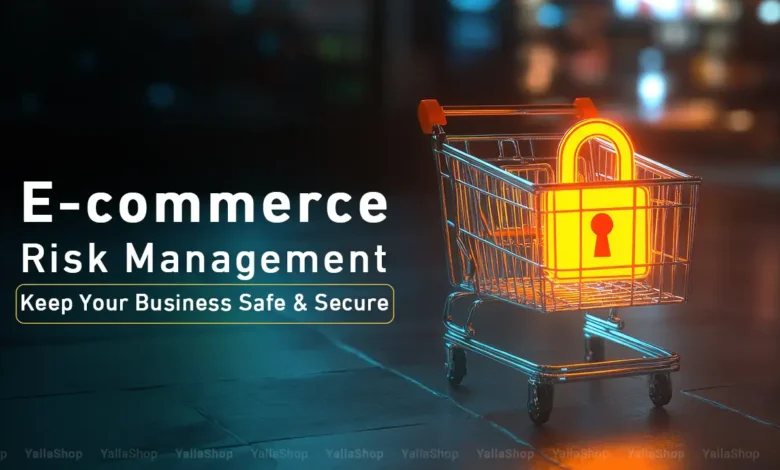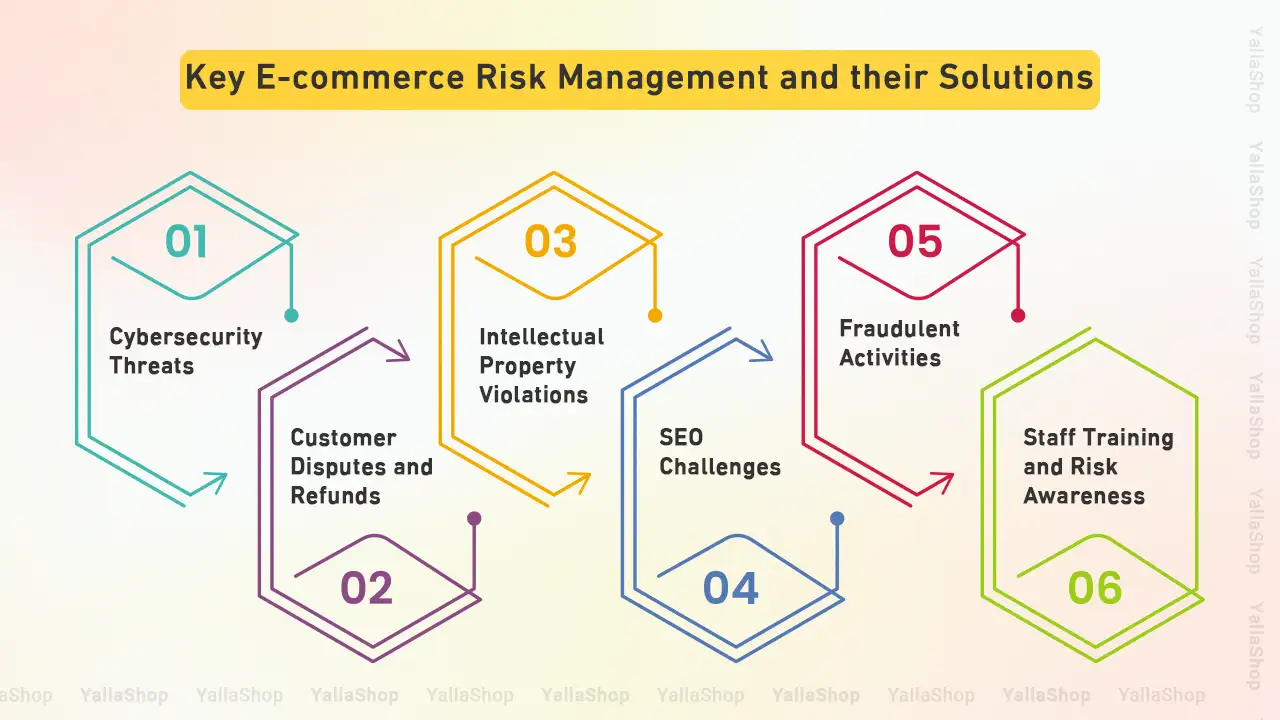
E-commerce risk management is evolving rapidly as online business continues to grow. While digital commerce offers countless opportunities for businesses to reach broader audiences and scale operations, it also introduces various risks that can impact brand reputation, customer trust, and financial performance.
From cybersecurity threats to intellectual property violations, identifying and mitigating these risks is essential for long-term success in a competitive digital marketplace.
🚀 Turn your idea into income.
Open your store with YallaShop in minutes.
One click. No hassle. Just growth.
Key E-Commerce Risks and How to Manage Them

In this section, we break down the most common e-commerce risks and provide practical solutions to help businesses protect their operations and customers.
1. Cybersecurity Threats
Cybersecurity remains one of the most pressing risks in e-commerce. Data breaches, malware, and phishing attacks can compromise sensitive customer data, such as credit card information, leading to:
-
Loss of customer trust
-
Financial penalties
-
Legal consequences
Solution:
To counter cybersecurity threats:
-
Use SSL certificates to secure transactions
-
Choose trusted e-commerce platforms with secure frameworks
-
Implement real-time monitoring systems
-
Update software and plugins regularly
-
Educate staff on cybersecurity best practices
Read More About logistics in e commerce: Optimize for Fast Shipping
2. Customer Disputes and Refunds
Disputes over incorrect deliveries, faulty products, or billing issues are common. Chargebacks, in particular, can be damaging—they reverse transactions and may result in:
-
Additional fees
-
Suspended payment processing
-
Increased operational costs
Solution:
-
Display clear refund and return policies
-
Provide excellent customer service
-
Track deliveries and confirm orders via email
-
Dispute illegitimate chargebacks when possible
3. Intellectual Property Violations
Online stores heavily rely on original content, branding, and product descriptions. Using copyrighted content without permission may lead to:
-
Legal disputes
-
Brand damage
-
Financial penalties
Solution:
-
Use licensed or royalty-free content
-
Create original branding and marketing materials
-
Conduct regular audits of website content
-
Train staff on intellectual property laws
Read More About Impact of e-commerce on business strategy 2025
4. SEO Challenges
Poor Search Engine Optimization (SEO) can result in low visibility, preventing potential customers from discovering your store. Without strong SEO, traffic and sales may suffer significantly.
Solution:
-
Perform keyword research for high-traffic, relevant terms
-
Target long-tail keywords
-
Create high-quality, original content
-
Optimize page speed and mobile responsiveness
-
Build authoritative backlinks
5. Fraudulent Activities
Fraud is a major threat in e-commerce, including:
-
Stolen credit card use
-
Fake refund claims
-
Manipulated return processes
Solution:
-
Use secure payment gateways with fraud detection
-
Enable two-factor authentication
-
Monitor transactions in real-time
-
Train staff to detect and handle suspicious activity
Read More About e commerce in egypt: Transforming How People Shop Today
6. Staff Training and Risk Awareness
Employees are often the first line of defense against risk. Lack of training can leave your business vulnerable to attacks, chargebacks, and customer dissatisfaction.
Solution:
-
Develop comprehensive training programs
-
Conduct regular workshops on fraud detection and cybersecurity
-
Educate teams on risk protocols and customer service best practices
-
Keep staff updated on the latest industry threats
Common Questions About E-Commerce Risk Management
What are the 5 steps of risk management?
-
Identify risks
-
Assess impact
-
Prioritize risks
-
Implement mitigation strategies
-
Monitor and review outcomes
What is the risk management approach to e-commerce security?
A comprehensive risk management strategy involves:
-
Implementing robust security systems
-
Staff training
-
Real-time threat monitoring
-
Choosing secure platforms and payment systems
Which of the following are risks of e-commerce?
-
Data breaches
-
Chargebacks
-
Intellectual property theft
-
SEO performance issues
-
Cyberattacks
Conclusion
E-commerce risk management is essential for businesses looking to grow and thrive in the digital space. While the opportunities are vast, so are the challenges—from cyber threats to SEO struggles, fraud, and intellectual property issues.
Companies that proactively address these risks by investing in technology, staff education, and clear internal policies are better positioned for long-term success. By understanding and managing the risks of e-commerce, businesses can build trust, safeguard their operations, and create a resilient online presence.

